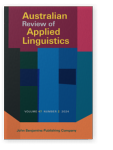Vol. 47:2 (2024) ► pp.129–152
A socio-psychological analysis of goal-setting when deciding to learn a second language
The Australian experience
This study bridges a gap in the current research on motivation and demotivation learning a second language (L2). It is meant to provide an overview of students’ goal setting when they start to learn an L2 at university level in Australia. Drawing on goal-setting and learning goal orientation constructs (cf. Miller, 2020), goal formation is deconstructed and analysed to throw new light on students’ psychological processes identified at the micro level and the influences on goal setting stemming from the social context at the macro level in which students operate. The interaction between the two levels is explored in order to understand which dynamics lie behind research participants’ desire of gaining proficiency in French, German, Italian, and Spanish. Qualitative data analysis outcomes are shown in an attempt to provide clear and applicable pedagogical suggestions for L2 practitioners (see, e.g., Al-Hoorie et al., 2021).
Article outline
- 1.Introduction
- 2.Literature review
- 2.1Goal-setting theory
- 2.2Goal orientation theory
- 3.Methods
- 4.Data analysis and findings
- 4.1The micro level of the psychological domain
- 4.2The macro level of the social domain
- 5.Discussion
- 5.1Research question one: What influences students’ goal-setting process in the micro-level psychological domain when they choose to learn an L2?
- 5.2Research question two: How does the macro-level social environment shape students’ goals during their decision-making process of learning an L2?
- 6.Pedagogical implications
- 7.Conclusions
-
References
